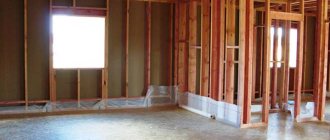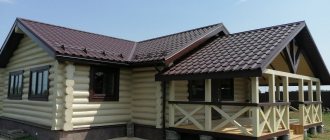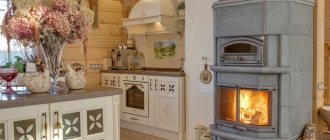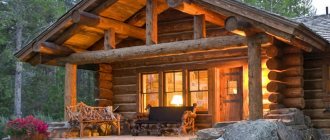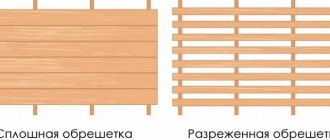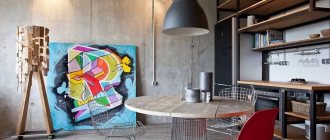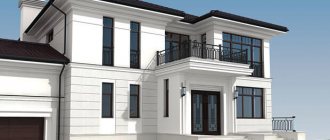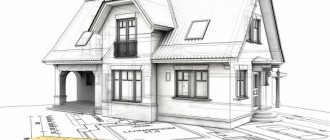To complete the architectural style of the house and harmoniously fit the building into the surrounding landscape, you need to choose the color of the roof wisely.
If you do not pay due attention to this issue, even the best design ideas will fade.
You can achieve the optimal color scheme for finishing a country house if you know how to understand the shades of the roof and walls in detail.
Choosing a roof color according to Feng Shui
According to Feng Shui, the ancient Chinese science of energy flows, the choice of color for the roof of a residential building significantly affects the well-being of the family living in it.
Within the framework of this teaching, the roof protects physically and spiritually those in the house from weather and energy phenomena. With a thoughtful choice of roof color, good luck, harmony, joy, health, prosperity, and prosperity reign in the house.
According to Feng Shui, colors symbolize one of several elements: wood, water, metal, fire, earth.
The most favorable of them include green, yellow, white and their combinations, that is, the colors of wood and metal. Less comfortable are black, blue, brown, red. But this does not mean at all that they cannot be used in the facade - it is worth trying to choose the most optimal, neutral shades. For example, coral, peach, beige, gray and others like them.
Decorative options
The resistance of colors to ultraviolet radiation and temperature changes varies: light and muted tones are more stable and practically do not fade. Dark and intense colors noticeably lose their brightness over the years. At the same time, dark and unusual lamellas are more expensive, since more expensive dyes are used in their production.
Texture – no less attractive is the ability of the material to imitate other natural surfaces. Wood and wild stone are in the lead. The manufacturing method makes it possible to reproduce the wooden structure, shape, and even the smallest defects characteristic of a natural surface. From a distance of a couple of meters, it is impossible to distinguish “palace stone” siding from real stone trim.
Basement and facade - in addition to lamellas that look like a board, and sometimes repeat it down to the smallest detail, base panels are also produced. They are larger in area, more resistant to wind and frost, which is why they are used to protect the base.
The panels usually imitate a stone or brick surface, but can also imitate shingles, wood chips, and shingles. A standard, but no less attractive way to decorate a building is a combination of panels of two colors. Lighter ones are used for finishing the facade, and darker ones, for a burgundy roof, for example, are used for cladding the base and corners. The photo shows an example.
Color psychology
Many experts and designers believe that the walls and roof of the house should be made in colors that best suit the character of the home owner. In order to decide on the desired color, the customer’s character is determined, after which he is offered several color solutions. A correctly chosen color will have a positive effect on a person’s mood; accordingly, he will not have depression and living here will always be very comfortable.
Conservatives are best suited to a dark brown roof color and a light façade painted beige, white or yellow. This is a classic combination, so this picture can be seen quite often. The owner of the house will be mentally calm and will be able to feel relaxed and protected within the walls of this building.
If the customer is an innovator in spirit and a brave enough person, then a house with a light brown roof and a dark gray or black facade will be ideal for him. A house made in such a color scheme is rare, however, it can also be found and often attracts with its originality. This type of building always looks very harmonious and peaceful, as if dissolving into the surrounding landscape.
If the future homeowner is a fairly calm person, then it is best to use single-spectrum colors. In this case, a minimum of decor is used so that it does not irritate the eyes of the house owner, and the colors of the roof and facade are very similar to each other. To prevent the facade and roofing material from merging into a heap, creating the appearance of a stain, it is necessary to choose colors that will be similar, but at the same time differ from each other by several tones. If desired, the façade of the building can be decorated with natural stone or other original items that can make the building not only attractive, but also unique.
About the general principles of color selection
House designs presented on numerous construction sites are in most cases made in neutral shades. This is done so that the colors do not distract from the details of the project, allowing you to more fully appreciate the design. The choice of colors for the facade and roof goes to the owner; it will be successful if you follow the simple rules that guide professional designers.
Before settling on a particular color scheme, you should decide whether you want to highlight your home, emphasizing its advantages, or, conversely, make it invisible, built into the environment. The solution to this question will tell you which direction to move in. The first option will require rich colors and bold combinations, while the second will require a harmony of natural shades.
For fans of extravagant solutions Source indeco.ru
When choosing colors for a country house, it is important to remember some features that are inherent in all colors, albeit to varying degrees. All of them have the following properties:
- Burnout . The more saturated and bright the color, the more noticeable it is. The champion in terms of burnout speed is black; brown, red and lilac roofing will be exposed to the sun to a lesser extent. The best durability is demonstrated by the gray color, which only slightly changes the shade. A white roof is also not ideal; elegant at first, over time it will inevitably turn yellow, and not evenly, but in spots.
- Heat absorption . We remember from a school physics course: the lighter the surface, the more it reflects light, and the darker the coating, the more it absorbs solar energy. Therefore, the further north the house is located, the more practical the choice of dark materials and colors for its facade and roof becomes.
Bright colors become lighter over time Source houzz.com
- Accentuation . Paints can change the external impression of a building. Light shades visually enlarge the object, dark shades make it smaller, but also give clarity to the details. Caution is needed when using several bright colors - this is usually a good solution for a house of a simple shape with a minimum of architectural details.
To simplify the task, it is convenient to approach the selection of a suitable color scheme in one of the following ways:
- Choice of shades of the same color . A common and almost win-win option. One color is divided into successive shades: for the roof, facade walls and smaller details. Buildings made in green, sand or brown tones look harmonious; more boldly - in red or blue.
Choosing shades of the same color Source dvamolotka.ru
- Choice of contrasting colors . The appearance of such a building will be bright and memorable. The color scheme is based on two maximum contrasting colors, for example, chocolate brown for the roof material and pale yellow or beige for the facade. Sometimes, to enhance the effect, facade details (doors, trim, plinth) are also painted to match the roof.
Selection of contrasting shades Source iteragroup.com.ua
- Combination with white color . A universal option, given that white harmonizes perfectly with both pale and rich shades.
The combination with white is also contrasting Source rooftrend.com.ua
- Combinations of several colors . A three-color combination is specified: brown – beige – olive or gray – pink – white. They are complemented by a suitable secondary tone, which is supposed to be used for finishing. With the right selection, even a black facade of a house, complemented by a light roof, will look harmonious and stylish.
Combination of several colors Source krona-yug.ru
Properties of colored roofs
Colored roofing not only adds aesthetics to the exterior of a house, it can affect the visual perception of the building as a whole, changing its configuration, making it more or less dimensional, hiding possible flaws and regulating the degree of insolation. Looking at this list, one can’t help but wonder, what can we expect from the color we like?
Roofs of dark colors absorb light and become very hot. These properties will be in demand in the northern regions. Southerners are better off giving preference to light-colored roofing materials.
The roof of a dark-colored house warms up well
Bright rich colors are picturesque, but they fade too quickly, and this type of roof can only be used on a house of simple architectural form, not burdened with a large number of small decorative elements.
Bright red roof of a house
White roofs are prone to yellow spots.
Private house with a white roof
Gray color is incredibly practical, but it is boring in decorative terms, so you will need an extraordinary façade decor.
Classic style house with gray roof
If the chimney facing the roof is wide and high, then it must be decorated in a shade identical to the main background of the roof. Small chimneys can be made an accent element by painting them in colors that echo the colors of the facade.
Optimal styles for applying brown color
Earlier we noted that brown color is not suitable for every home and its style direction must be taken into account. If the choice fell on brown shades even before the construction of a private house began, then you need to find out which styles it is best combined with in order to build a house in accordance with one of them. If you strive for something original and combine a different style, you may fail, the appearance of the house will not be attractive, and the final result will not bring the necessary positive emotions.
Styles with which brown and its shades go best:
Classic style. In this case, this option will be optimal; it is almost impossible to make a mistake with it. The key is to use the right combination of colors to create an attractive home exterior. In order for a private home to look interesting and stylish, you need to combine brown with light or pastel colors. The optimal solution would be white, milky, beige and creamy colors. It will be even better if they dominate the design of the house, and brown complements them. The classic style welcomes simple geometric shapes and lines; large facade elements would be inappropriate here. The windows should have light-colored edging; this move will make the windows more expressive, and the house itself will visually become sophisticated and charming. Antique. Another style that welcomes the use of brown. In this style, elaborate decor will be appropriate and will emphasize the dignity and wealth of the house. You can also add bright shades to the design of the facade, the main thing is that there are no glossy coatings. The best option for a combination of red and brown, they will create an interesting appearance, emphasizing the naturalness of the house and the refined taste of the owner. Country. This style best brings the house closer to nature, so this style direction will be the optimal solution for country houses and cottages. When decorating the facade, it is recommended to use only natural materials. Since brown color is natural, when decorating the facade you can use wood, wooden panels and other materials that have a similar color or its shades. A house made of timber, both rounded and regular, looks gorgeous. The timber has a delicate and pleasant light brown tone, which means that an abundance of decor is not needed here. When decorating the facade of a building, you can use pastel colors, which are considered natural
It is best to pay attention to beige, white and light green shades, as well as tones close to them. It is worth noting that a country-style house brings you as close as possible to nature and will fit perfectly with the landscape.
When building a house and decorating the facade, it is necessary to take into account the combination of colors, their correctness and compatibility. Brown is a natural color and gives a building aesthetic appeal, sophistication and originality, despite the frequency of its use. Brown and its shades are best combined with pastel colors, as well as red, green or blue. Thus, you can not only create an original design for the exterior of the house, but also express the individuality of the owner, show his sense of taste and style, and bring original or crazy ideas to life.
The main task when decorating the facade will be the correct selection of colors, combinations of shades and their percentages. To make the building seem more majestic and spacious, it is best to use light colors, and use brown as a complementary color that will complement beige, milky or white colors. In general, the more light the palette, the more advantageous the house will look; the brown color will set off the light tones, creating color, adding sophistication to the exterior of the house.
Harmony of white stucco and gray in the exterior of the house
Despite its gloominess, the gray tone in the exterior of a country house can symbolize homeliness and comfort. To do this, it is enough to beat it with a large amount of white decor.
Highlighting entrance lobbies, cornices, and windows with light colors dilutes the design of the facade. This will make the building welcoming and family-friendly.
A large amount of light, glass, open structures, outdoor recreation areas, and greenery are also welcome. The combination of green, white and gray colors in the exterior of the house is considered one of the most successful. Greens are usually used in landscape design and flower beds. Nature effectively brings the design to life.
The best color combinations with a red facade
The color combination primarily depends on what particular shade of red was used to decorate the facade of a private house. If the facade is bright red, then it needs to be diluted with a neutral and soothing color, for example, gray. This color can be used both for window and door openings, and for decorating the roof of a private house, creating an original appearance for the building. It is worth noting that gray is generally the best solution for creating a color duet. The roof of a private house, covered with natural light gray tiles, goes well with any shade of red. If the building has a large base, then it can be faced with natural stone or its imitation, made in a gray palette.
Another original option for combining red with other shades is a pair of red and white. Snow-white edging of doors and windows, cornices and drains can diversify the bright terracotta shade of the facade, making it original and attractive.
There is a rule in color design that red and green do not go together. However, every rule has an exception, especially when using the right shades. A brown-terracotta facade will look chic in combination with dark emerald decorative elements and window frames. Using these shades you can break all concepts of compatibility, creating the perfect duet.
It is not difficult to clad the façade of a private house in red; the easiest way to do this is with the help of modern siding. Vinyl siding is actively used for facade decoration, and its richness and technical parameters will allow you to create a dream home that will not only be beautiful and original, but also resistant to all negative environmental influences.
White
Classic white facades will also look great in combination with a brown roof. These houses look a little old-fashioned. After all, white and brown are a classic way of decorating houses, used for more than one century. To make the interior of such a house brighter and catchier, you can paint the door, window frames and porch brown.
It’s not the price of clothes that matters, but your taste: stylists debunk myths about men’s fashion
Yulia Mikhalkova from “Ural Dumplings” decided to become a screenwriter
Two-color banana pie with cocoa and without sugar: a healthy dessert recipe
How to choose the right shade?
Before choosing the required shade, you need to ask yourself the question of what exactly is expected from the house, what functional load it will carry and how this shade will make it special. In general, you need to choose the color and its shade, relying only on your perception and personal taste, because the house can either harmoniously combine with the landscape, or vice versa, be a bright spot against the general background.
If the walls of the house are covered with siding, then it is necessary to take into account the finishing of the facade when choosing the shade of the roof. In general, the color of the roof and the facade should be combined with each other as much as possible; you need to take into account whether warm or cold colors are used. The green color of the roof is universal, so you can decide on frank ideas and bring the most unusual ideas to life.
The most popular schemes for combining facade and roof:
- Dark roof and light wall decoration. In this case, you can get closer to the classic style, make the house elegant and interesting in appearance.
- A light roof and dark walls is a less popular option, however, it can be used to create an unusual effect. Looking at such a house, it seems that it can disappear into the clouds, and this is what many brave people like.
- Color harmony of the roof and facade using one tone. In general, this option will connect the roof and the facade; this option is monolithic, but very boring and will quickly get boring, so not everyone can decide on it.
Selection of color solutions for roofing and facade
Currently, there is a large selection of colors for roofing and facade materials. When purchasing, it is necessary to take into account their technological features, quality, service life, and ensure a harmonious combination of shades.
First of all, it is worth studying the tones and texture of the proposed material. Shades of natural colors look natural and are often used in classic designs.
If the roof is in harmony with the overall style and the garden plot, this combination looks like a whole picture, without separate parts or scattered details.
If the walls of the building are sheathed with siding or laid out of brick, then initially a guideline is taken on the color of these walls, and the roofing material is selected to match their tone.
When selecting colors, the following factors are taken into account:
- priority determination of the shade of the facade of the house. You need to decide for yourself what the house will be like - cozy and homely or impressive and majestic. Currently, there are specialized programs on the Internet that can select online the color composition of house elements - it’s worth using them;
- selection of roof color;
- accounting of the location of the house. So, for the northern regions, bright, saturated shades are most acceptable;
- the presence of vegetation in the local area. If there is a shortage of it, the use of natural shades is what is needed for the facade;
- a laconic addition to the structure with a color accent. For example, in a classic, traditional style, bright, pretentious shades are not recommended;
- the influence of tones on heat transfer: dark colors absorb heat, light colors repel the sun’s rays;
- selection of discreet door blocks so as not to attract undue attention.
It should be noted that when constructing the façade of a house in warm colors, the roof should not be designed in cold colors, and vice versa.
The most common combinations of facade and roof colors:
- light walls and a dark roof - a traditional option, loved all over the world;
- plain roof and walls - the house looks uniform and laconic, but there are no color accents;
- dark walls and a light roof are a rather rare combination, it looks quite interesting, it looks as if there is no roof - it has disappeared into the clouds.
Color compatibility table
Of course, the final choice depends on the taste of the home owner, but in order to make the choice not so difficult, it is easier to use the compatibility rules. The most trustworthy and popular are special tables developed by Swedish psychologist Max Lüscher. Based on his recommendations, specialists compiled a table relating to the issue of combining the colors of walls and roofs and ensuring maximum color harmony.
5 means an excellent combination, 4 means quite acceptable, 3 means not very good, 2 means incompatible.
Sun resistance
By experimenting with the colors of the facade, you can transform the house, make it more interesting and attractive in appearance. Using different colors you can increase the aesthetic value of your home, bring your ideas and ideas to life, or add meaning and meaning to your home. The correct choice of color can completely change the perception of the building, visually making the house larger or smaller. By combining a color palette, you can make the house deeper, directed upward, or exactly the opposite, the main thing is to feel the proportion.
The brighter the color, the shorter its lifespan, as it is more susceptible to exposure to sunlight. Black color is the worst option, since it attracts ultraviolet rays the most, which means that its service life is minimal. The best option would be to use pastel and light colors that can last for many years. Pure white color looks elegant, but it also cannot look beautiful for a long time, it will quickly begin to fade and turn yellow.
It is best to use gray and its shades - this color does not fade, it does not turn yellow, and dust on such a facade will not be noticeable. Even if the shade changes slightly over time, this will not be a problem.
Properties of different colors of roofing materials
A colored roof will not only make the house aesthetically attractive, but will also change its visual perception, make the house appear larger, or vice versa. A dark-colored roof absorbs ultraviolet rays from the sun, as a result of which it quickly heats up and the microclimate inside the house can be disrupted. A roof that is too light, on the contrary, will repel the sun's rays, but over time it will begin to turn yellow and lose its former attractiveness.
A few operating rules
If you decide to work with the presented color yourself, then the following tips will help you:
- A monochromatic design will look quite boring. It is worth noting that if you choose a dark tone, then the building will also be gloomy. The dark coating of walls and other facade elements visually narrows and makes a private or country house smaller. This will negatively affect the exterior;
- You need to choose the right style. This is the main condition before starting work. Today there are several directions that are suitable for using brown. We will talk about them further;
- Consider the geometry of the house. For example, if the building has an unusual exterior, bulky and pretentious elements, then it is better to refuse to use the presented option.
What to do if the choice is limited?
Choosing the desired color of metal tiles or other metal products is not difficult, since the choice is quite rich.
But with natural tiles things will be more complicated. There is a way out in any situation. The developer can choose the roofing paint of the desired color and paint the roof. Metallic coatings are best suited for painting. An alternative is to use Euro slate, the range of which is quite rich.
Unacceptable Practices
The following decisions will lead to deterioration in the appearance of the building:
- Use in wall decoration more than 4-5 colors
. The result may surprise you, but it is unlikely to please you.
- Usage incompatible or
several
bright
, interfering shades.
An error in choosing a color worsens the perception of a home. Source doka-metal.ru
- The façade and roof must be completed either in warm or cool colors
; otherwise there will be no harmony.
- Use in decoration of the whole house obottom color
.
- Not the best solution - copying the decoration of neighboring houses
. It is enough to choose colors that match the tone or style.
- If you want to do emphasis on small details
(door and window frames, cornices, pipes), use
one shade
so as not to create the impression of diversity, which is tiring for the eyes. - So that the house does not resemble a children's construction set (only if you do not achieve such an effect), the ideal flowers for accent
will become
white, black and gray
rather than red, blue or yellow.
For a black facade, the main thing is accentsSource otdelka-trade.ru
How to Achieve Your Best Look
The main color of the building should not violate the overall style of the street and be in harmony with nearby buildings. You cannot ignore the selected warm or cold colors in the rooms and the surroundings: forest, garden, pond or open area.
Trees, bushes, field and house should not be the same color. In this case, choose white or light gray. Sometimes a green facade with a brown roof in a pine forest is preferable. Flashy purples, reds and oranges are not acceptable for urban environments because they are too noticeable.
Colorful walls are inappropriate for a small dacha, but for a separate building this is a completely suitable option. Bright colors such as fuchsia, yellow or turquoise are acceptable for industrial areas or northern regions, where winter weather is almost always dull.
In any case, the choice remains with the owner, who decides for himself how thoroughly he should treat the appearance of the house in which he will live.
How to match the color of the facade to the roof?
When choosing plaster or paint for walls, remember the chosen shade of the roof. When roof slopes are sloped, their large surface area has a significant impact on the appearance of the building.
What color should the façade be painted? The walls must be in harmony with the design of the remaining elements of the building:
- window and door frames;
- pipes, drains;
- base,
- garage door,
- columns,
- stairs.
Roofing materials are dominated by shades of red brick and gray. The most commonly used are various types of tiles and roofing sheets. It happens that a certain shade is only available in certain materials.
The specific shade is also influenced by:
- incident light,
- material type,
- form,
- texture,
- texture.
For example:
- red ceramic tiles look completely different than red shingles;
- metal tiles sparkling in the sun seem brighter than matte ceramic tiles of a similar tone.
This should be taken into account if you plan to choose a bright shade of façade material. Mixing two intense colors looks too intrusive, causes an undesirable variegated effect that is tiring for the eyes
The size and relative proportions of the wall and roof planes should also be taken into account:
- a large dark roof will overload the exterior and visually make the building lower;
- if the walls create a small area, they need to be lightened, visually enlarging them.
A dark facade looks impressive when combined with a dark roof, but this option needs to be carefully considered. The dark building looks a little extravagant; not everyone will like it.
Features of colored roofing
Colored roofing material is not only an opportunity to create an attractive and unusual exterior of the house, but also a chance to influence the appearance of the building as a whole. With the right choice of color, you can change the configuration of the building, making it larger, or vice versa, while hiding all the flaws.
A dark-colored roof strongly absorbs the ultraviolet rays of the sun, causing it to heat up greatly, so dark shades are best used in the northern regions of the country. In the southern part of Russia the opposite is true; here it is better to give preference to light shades. Bright roofs are original, beautiful and unusual, but not practical.
Painting paints quickly fade, lose their attractive appearance and require replacement of the roofing material. A white roof is not the best option, as yellow spots will quickly appear on its surface. Gray color is the optimal and practical solution, but many may find it boring. To get rid of such feelings, it is necessary to decorate the facade in an original way.
What's the best way to use gray in your home's exterior?
Gray color in the exterior of the house has become one of the most popular due to its severity, effectiveness, neutrality and achromatic appearance. Correct use of gray tones on the facade will help add high cost, presentability and aristocracy to the building. The object receives a strict, respectable appearance, symbolizing the high status of the owner.
A few simple techniques and rules for using gray on the facade will help you avoid the gloom and dullness of the situation. It is important that the wrong tone can make the atmosphere at home boring and unfriendly.
